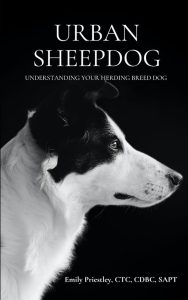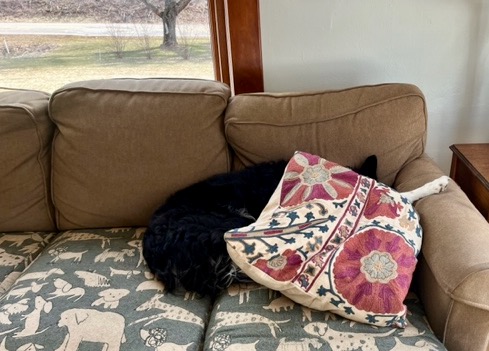I don’t pretend to be able to keep up with all the dog/animal behavior books being published right now, but two books got my attention this week that I thought you might find interesting. In some ways, they couldn’t be much different from each other. Who’s a Good Dog? And How to Be A Better Human, by Jessica Pierce, is a beautifully-produced book published by The University of Chicago Press, has perhaps the greatest title and cover of any dog-related book I’ve seen in a long time, and has a nine-page index. Urban Sheepdog: Understanding Your Herding Breed, by Emily Priestley, is published by . . . ? (All it says is Made in the USA, Monee, IL). It is a small, almost booklet-size book, presumably published and printed by the author. (But I still love that cover. What a gorgeous photograph.)
The differences go far beyond structure and publisher. Who’s a Good Dog? is as far away from a dog training book as you can get, by design, while Urban Sheepdog focuses on the quirks and pecularities of cattle dogs and border collies. However, what strikes me most is that both books, in some ways as different as two books about dogs can be, both ask the reader to accept the dogs they have, rather than trying to turn them into the fantasy “perfect dog” that some seem to strive for.
Let’s take Who’s a Good Dog? first. Jessica Pierce, a well-published bioethicist and author (her work includes, for example, Run, Spot, Run: The Ethics of Keeping Pets), makes no bones in the introduction that her dog, Bella, is NOT, “by outside standards,” a good dog. She gives “warning nips” to strangers, bites Jessica’s feet in bed if she accidently kicks her, and doesn’t do what Jessica asks “unless it aligns with her own agenda . . . “. And yet, Jessica says: “Bella occupies my heart and soul,” and it’s hard not to appreciate someone who loves her dog so much.
What I like about the book (full disclosure, I’ve only read about half the book; the reason will be clear at the end of the post) is the overarching theme of the importance of AGENCY in the life of dogs, along with the challenges that companion dogs have trying to adjust to living with us. Like many in the recent past, there is an increasing awareness that, while pet dogs have advantages street dogs don’t–great food, health care, safety, love–they pay for it in loss of autonomy, and deal with environmental stressors that aren’t always obvious. (See, for example, my post Quiet, Please from 2018.)
However, Pierce sometimes over states her primary thesis. She tells us that “The millions of dogs living in close association with humans are in crisis.” She backs this up with a study that found 3/4 of the dogs (14,000 of them) “suffer from some anxiety-related problems.” A third of these dogs were nervous around thunderstorms and fireworks, which she later argues are normal reactions of dogs to loud noises, but “anxiety experienced by pet dogs [to loud noises], goes well beyond any adaptive response to the environment.”
Another study she cites supporting her “in crisis” assertion, found that a large percentage of dog owners reported that their dog has “unwanted behaviors.” This morning Maggie tried to eat unknown animal poop on our wood’s trail. I said leave it, and she did. Is this an unwanted behavior? Yup. Is this a crisis, for either me or Maggie? I don’t see it. At the moment she is sound asleep on the couch, while Skip snoozes in the sun after bringing the sheep down for their breakfast. I admit to not a drop objectivity about my own dogs, but you are going to have to provide a lot more evidence than Jessica did to convince that most companion dogs are truly in crisis.
And yet, despite undermining her own arguments, there is a lot of value in what she has to say. She argues, convincingly, that our relationship is a collaboration–that dogs are doing their best to adapt to an alien culture, and we must do the same–to respect them as dogs, not extensions of our often unrealistic expectations. She begs us to be better observers of our own dogs, to have a “beginner’s mind” and see dogs without the filter of who they should be, and what they should do.
She talks about the ethical implications of controlling every bite of food a dog takes, and even when and where they are allowed to potty. (She gives Bella the last bite of every meal she eats, with the obvious health/safety restrictions, a ritual I find endearing.) She includes a Resource Section at the back which includes good things like Whole Dog Journal and the Fear Free Movement for fear-free handling in veterinary clinics.
I do struggle with the book at times. She often decries the advice of “experts,” although she doesn’t tell us who they are. I don’t see much, if any, credit given to the many others talking about agency in dog training and behavior, like Chiraq Patel and his bucket game, as just one example. I wish she had; type in “Agency and Dogs” in Google and you’ll be overwhelmed with references to it. (Apparently I am unable to resist mentioning my post on “Asking vs. Telling“ from last year, although I have tried.) There are times I find myself downright irritated while reading Who’s a Good Dog?, but as an acupuncturist once told me in another context when I whined in pain, “You not here to feel good, you here to get better!”Ha!
Beyond complaints about her thesis being overstated, and not giving credit where credit is due, the book forces me to think at a deep level about my relationship with dogs, and how we can all be better humans around them. And surely that’s a good thing, so while I’m grumping a bit, I’m glad I’m reading it. (FYI, Dogwise is doing a Live Facebo0ok/Youtube interview with the author on March 7th, 10 AM Pacific.)
Urban Sheepdog, also asks us to understand that the human-built environment that we often put dogs in can cause them to suffer. Emily Priestley, CTC, CDBC, SAPT, is a professional dog trainer in the Vancouver area who sees mostly heelers and border collies who live in the city. Although it’s a small book (($19.99 feels a tad steep for its size and content), I was hoping for some solid advice about how to handle herding breeds in over stimulating environments. (Overstimulating, at least to them. Okay to me too, I’d start licking my paws and growling if I lived in a busy city.) Regrettably, there’s not a lot of that, but there is some very good information about why herding breeds behave as they do.
She reminds us that it’s no surprise that border collies tend to be sound sensitive, given they were bred to respond to whistles three quarters of a mile away. The book has short sections on how sensitive many border collies are, which, as their owners often know, is both a good and problematic trait. Skip won my heart for life when he swirled back and lay down beside me when I slipped on some mud and yipped in surprise. And it’s tiresome when he runs to me, wide-eyed, when I say “Oh no!” to a friend I’m talking to on the phone who can’t find her car keys. We read about herding breeds being hyper-responsive to movement, barking Kelpie’s, and nipping heelers. (I love her comment about people who are surprised when heelers bite heels: “It’s right there in the name, and these dogs are very prone to it!)
She makes some thought-provoking comments: She says she doesn’t believe that fear periods exist, claiming the behaviors seen during these times have “more likely causes.” (She cites the onset of genetic predispositions as one.) My favorite section might be when she talks about her biggest pet peeve–that the primary reason for behavior problems in herding breeds is because they don’t have a job. She argues credibly that “. . . reactivity, compulsive disorders, fear and aggression are not caused by not having a farm or a job . . .”. Herding breeds, bred to be reactive, to control movement, to be hyper sensitive to sound and environmental changes, are set up to struggle in urban environments.
Chapter Five summarizes the traits and potential problems she sees in typical herding breeds, arguing for example, that Australian Cattle Dogs (also known as Heelers), can be standoffish with strangers, reactive, nippy, and subject to “trigger stacking” more than other breeds. What I like about this small book is that it cautions owners of herding breeds to understand better the dog that they have.
But, then what? What does one do with their sound sensitive, hyper-reactive border collie, corgi, or heeler? I know from years of writing and speaking, that people want answers. (Recall the comment on Amazon about The Other End of the Leash, that, in spite of it’s subtitle Why We Do What We Do Around Dogs, it had NO training advice and was barely worth using the pages to pick up dog shit.) Given that the Emily works almost exclusively with herding breeds in an urban setting, I was expecting more about how she advises clients to deal with their dog’s inner nature. She argues that owners have a duty to give the dogs an approximation of what they were bred to do. But then she tells us she plays fetch with her dogs daily. That is indeed exercise, but I assure you it’s nothing like working livestock, except it gets your dog moving. She mentions collie balls, jolly balls, tug toys, and flirt poles (her favorite), as ways to exercise dogs in small areas, but it’s a short section covering only three pages.
I want to adore this book. I suspect I’d adore Emily if I met her, that she does great work, and that she has a lot to tell us. I’m just not sure it’s in this book. I would LOVE it if she’d come out with another edition, expanded to include more of, for example, handling a sound sensitive dog in a noisy city. (But check out her webinar on Understanding Sound Sensitivity, could be helpful.) This would be a good book, as is, for breeders of herding dogs to give to potential adopters and puppy buyers, whether they live in a city or not, because the author does a good job saying, between the lines, that dogs of these breeds aren’t for everyone.
There are more books in my study that I haven’t gotten to. Jump in and help me out–what dog-related book are you reading now that you think the rest of us would enjoy?
MEANWHILE, back on the farm: For those of you who skipped the book reviews to read about farm adventures, I apologize in advance. Our latest adventure here is the excitement of Type A Influenza, the kind that puts old people like us in the hospital. Or worse. Worse is what I worried about last week, when Jim’s lungs were so bad it sounded like he was drowning. He has never been so sick in the twenty-four years I’ve known him. I’ll spare you the details, but we got him on anti-virals, I tried obsessively to avoid it, but, of course, didn’t. We are both coming out the other side, but are still isolating until we are no longer contagious. (Yes, we did get a flu shot late last fall, it might be that’s what kept us out of the hospital. Who knows.)
So, where I’m going with this is that working on the above, today and over the weekend, along with the chores and dog care we have, pretty much uses up the energy I have. At least I’m sure Jim is going to be okay, I am no longer the subject of the joke “first you were afraid you’d die and then you were afraid you wouldn’t,” and it’s sunny outside. Maggie has a strained neck or shoulder (of course), so Skip needs to be exercised separately.
I leave you with just one photo, of the amaryllis blooming in the dining room:
Delightlful!
Wait, Jim just took this: Maggie’s comment on listening to us cough and get NO EXERCISE. (An upset Maggie always talks in capital letters.)
May your week be full of delight too. Let us know if you’ve read either of the books above, or what you’ve been reading you think we might enjoy.

































